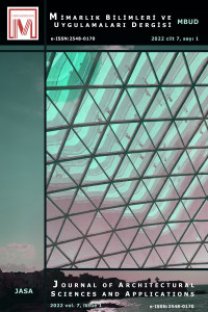Tasarım ve Malzeme İlişkisinin Sürdürülebilirlik Bakımından Çok Boyutlu İncelemesi
Sürdürülebilir tasarım, malzeme, enerji kaynakları, üretim süreci
A Multi-Dimensional Analysis of The Relationship Between Design and Material in Terms of Sustainability
Sustainable design, material, energy sources, production process,
___
- Akkuş, M. (2011). Hayatı ve düşünceleri ile bir iktisatçı: Ernst Friedrich Schumacher. İş Ahlakı Dergisi, Turkish Journal of Business Ethics, IGIAD, Volume 4, Issue 7, pp. 131-136.
- Alışveriş rehberi. (2017). Arçelik. Access address (01.04.2017): http://www.alisverisrehberi.com/reklamlar/arcelik_50_tasarruf_50_indirim.756.html
- Bony, L. J. & Lee, D. (2009). Cradle to Cradke Design at Hermen Miller: Moving Toward Environmental Sustainability. HBS Case No. 6607-003, Harvard Business School Technology & Operations Mgt, Unit.
- Bozloğan, R. (2004). Sürdürülebilir gelişme düşüncesinin tarihsel arkaplanı. Sosyal Siyaset Konferansları Dergisi, Issue: 50, pp. 1011-1028.
- Byars, M. (2006). New Chairs-Design, Technology and Materials. Aurence King Publishing, London, pp. 28-142.
- Çınar, A. K. (2014). Hititlerde Tanrı ve Tanrıçalara atfedilen bazı isim, sıfat, unvan ve yakıştırmalar, (The Gods and Goddesses Attributed to Some Nouns, Adjectives, Title, and Compliments in Hittite). Router Educational and Social Science Journal, Volume 1(2).
- Elbastı, G. & Alaçam, S. (2016). An Investigation on Growth Behavior of Mycelium-based Material In A Fabric Formwork. Conference: ASCAAD 2016: The 8th International Conference of the Arab Society for Computer Aided Architectural Design, London, United Kingdom. https://www.researchgate.net/publication/326786346_An_Investigation_on_Growth_Behaviour_of_Myceliu m_in_a_Fabric_Formwork
- Empapst. (2017). Access address (01.04.2017): http://www.ebmpapst.com.tr/tr/products/product_news/energy_saving_fans_made_of_
- Fiell, C. & Fiell, P. (2002). 1000 Chairs. Taschen Publisher, London, pp. 465, 560-563, 597.
- Günal Ertaş, D. (2007). The Effects of The Structural Characteristics on Industrial Product Design (The Ph.D. Thesis). pp. 120, 121, İTÜ Institute of Science, İstanbul.
- Günal Ertaş, D. & Şatır, S. (2010). Developing sustainable structural design features. A-Z ITU Journal of the Faculty of Architecture, Vol 7 No 1, Spring 2010, İstanbul.
- Günal, Ertaş, D. & Şatır, S. (2021). Furniture as a design product. Online Journal of Art and Design, Vol 9, Issue 1, sa:115-129, January 2021, ISSN: 2301-2501.
- Herman Miller. (2017). Access address (01.04.2017): https: www.hermanmiller.com/research/solution- essays/all-about-the-molecules.html
- Hill, H. (1993). Die Neue Verwaltung Nachhaltige Entwickeln. Die Öffentliche Verwaltung, Heft 2, pp. 56.
- Holtewerta, P. & Bauernhansla, T. (2016). Interchangeable Product Designs for the Increase of Capacity Flexibility in Production Systems. 26th CIRP Design Conference, doi:10.1016/j.procir.2016.04.129b
- Interchangeable Products with an Advantage. (2023). Access address (01.06.2023): https://www.appleton.emerson.com/documents/brochure-interchangeable-products-an-advantage- appleton-en-8632684.pdf
- John Deree. (2017). Access address (01.04.2017): https://www.deere.com/tr_TR/regional_home.page
- Kaplan, A. (1999). Küresel Çevre Sorunları ve Politikaları. Mülkiyeliler Birliği Vakfı Yayınları: 19, ISBN 975-7400-07-6, Öteki Matbaası, Ankara, pp. 160.
- Kasap, G. C. & Peker, D. (2011). Çevreci bir yaklaşım: Yeşil tasarım. BER-Business and Economics Research Journal, Volume 2, ISSN: 1309-2448, pp. 101-116.
- Keoleian, G. A. (1995). Life Cycle Design Framework and Demonstration Projects: Profiles of AT&T and allied signal. US Environmental Protection Agency, Office of Research and Development, Washington DC., pp. 7.
- Kıvılcım, İ. (2013). 2020’ye Doğru Kyoto-Tipi İklim Değişikliği Müzakereleri - Avrupa Birliği’nin Yeterliliği ve Türkiye’nin Konumu. İktisadi Kalkınma Vakfı Yayınları, Yayın No: 268, İstanbul, pp. 15.
- Liu, I. & Wong, J. (2013). Eco Design Furniture. Promo press, printing in Slovenia, pp.10-154.
- O’Riordan, T. (1998). The politics of sustainability. Sustainable Environmental Management Principles and Practice. R. Kerry Turner (ed.) Belhaven Press, London, pp. 29-50.
- Özcan, G., Çelebi, N. G. & Arpacıoğlu, Ü. (2022). Portable irrigation system producing water from air for sustainable living: Eco-Water-Gen. Journal of Architectural Sciences and Applications (JASA), 2022, no: 7 (2), pp. 501-510, e-ISSN: 2548-0170.
- Priewe, J. F. (1974). Produkt und Umwelt-Ergebnisse einer Ausschreibung. Druckerei A. Hentrich, Berlin, pp. 23- 120.
- Schumacher, E. F. (1995). Küçük Güzeldir. çev: Osman Deniztekin, 3. Baskı, Cep Kitapları A.Ş.,İstanbul.
- Sheridan, M. (2007). The Furniture of Poul Kjærholm: Catalogue Raisonné. Published by Gregory R. Miller & Co., New York, pp. 32-48.
- ShopSM. (2017). Access address (01.04.2017): https://www.shopsm.com/collections/home/products/philips- essential-led-light-bulb-5w-cool-daylight
- Sonego, M., Echeveste, M. E. S. & Debarba, H. G. (2018). The role of modularity in sustainable design: a systematic review. Journal of Cleaner Production, Volume 176, 1 March 2018, pp. 196-209.
- Torunoğlu, E. (2023). Sürdürülebilir Kalkınma Paradigması Üzerine Ön Notlar. Tübitak Vizyon Paneli.
- United Nations Sustainable Development. (1992). Agenda 21. United Nations Conference on Environment & Development, 3 to 14 June 1992, Rio de Janeiro, Brazil. https://sustainabledevelopment.un.org/content/documents/Agenda21.pdf
- United Nations. (1998). Kyoto Protocol to The United Nations Framework Convention on Climate Change. https://unfccc.int/resource/docs/convkp/kpeng.pdf
- Yüksel, E. (2012). Mobilya tasarımında çevre dostu yaklaşımların tarihsel süreci. İkibin 50 Sürdürülebilir Gelecek Dergisi, Issue 1, pp. 48-51.
- Yayın Aralığı: Yılda 2 Sayı
- Başlangıç: 2016
- Yayıncı: Atila GÜL
Ampirik Termal Konfor Değerlendirme Yöntemlerinin Bulanık Mantıkla Zenginleştirilmesi
Okul Bahçelerinde Açık Hava Sınıfı Tasarımı Üzerine Bir Araştırma
Elif ŞATIROĞLU, Selda AL ŞENSOY, Abdullah Yasin DÜNDAR
Cephelerde Müdahale ve Hasarların İncelenmesi: Selamsız Ucuz Evler Örneği İstanbul, Türkiye
Hatice Yasemin ÇAKIR, N. Volkan GÜR
Sur Dışındaki Zeytinburnu Mozaiklerinin Ortaya Çıkarılma Süreci
Olcay AYDEMİR, Emine Sibel HATTAP
Kırsalda Yeni Yerleşimlerin Değerlendirilmesi: Erzincan İli Tercan İlçesi Kalecik Köyü
Tülay İNANÇ, Cahide AYDIN İPEKÇİ
Geleceğin Kentlerinde Kamusal Alanlarda Cinsiyetsizleşme Eğilimleri
Cinsiyet ve Kontrollü Çevreler Arasındaki Etkileşim: Uyaran Algısı Üzerine Bir Çalışma
Kentsel Dayanıklılığı Sağlamak için Yöresel Mimarlığı Keşfetmek: Mimarlık Eğitiminde bir Deneme
Rengin BECEREN ÖZTÜRK, Arzu CAHANTİMUR
Güneş Enerjisiyle Havadan İçilebilir Su Elde Edebilen Yazılım ve Donanım Destekli bir Sistem Önerisi
Mimari Tasarımda “Yeniden Kullanım” Üzerine Bir Stüdyo Çalışması
